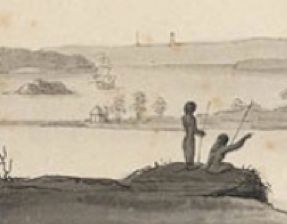At the beginning of June, an eager group of 30 historians travelled by rivercat to Kissing Point, two kilometres south of Ryde, in the suburb of Putney on the Parramatta River.
The excursion was organised by Judy MacGregor, of the Bennelong Reconciliation Group, as part of the Gai-mariagal festival which celebrates Aboriginal culture and heritage in the Northern Sydney region. The festival runs from Sorry Day until the end of NAIDOC Week in July.
Historian, author and curator Keith Vincent Smith led the excursion and on the journey from Circular Quay to Kissing Point pointed out the areas dominated by the Burramattagal, Wallumedegal, Cameragal and Cadigal river clans, as they were in the year 1790.
Smith told the group about Woollarawarre Bennelong, the Wangal man who lived on the Parramatta River, and survived on the bounty from the river, with its salt marsh, reed swamps and mudflats, a rich fishing ground and source of mud oysters, shellfish, crustaceans, ducks and other birds.
Wangal territory was on the south bank of the river eastward from the Flats (Homebush) to Goat Island (Memel), terminating at Darling Harbour.
The Wallumedegal, or Wallamattagal (Snapper Clan), occupied the north shore of the river, running east from Burramatta (Parramatta) to the Lane Cove River.
Bennelong was about 24 years old in January 1788 when a convoy of British sailing ships brought 1,000 men, women and children to Sydney Cove, to establish the convict colony of New South Wales, an event that would change his life forever.
In mid 1789 smallpox swept through the Aboriginal population. Bennelong survived. However, the epidemic killed half the Aboriginal people, including his first wife, whose name is not known. He was captured the next year, on the orders of Governor Arthur Phillip. He escaped, but “came in” peacefully to the settlement at Sydney Cove in November 1790 with his second wife Barangaroo. Phillip built him a four-square-metre brick hut on the eastern point of Sydney Cove, now called Bennelong Point.

North-West View, taken from the Rocks above Sydney, in New-South-Wales, for John White, Esq, c.1794. Thomas Watling (c.1762-?)
Wash drawing.
DG V1/13, Dixson Library, Courtesy of State Library of New South Wales, Sydney.
The governor and his prisoner soon found ways to communicate and exchange information. Bennelong quickly learned simple English and adapted European manners. He became a valuable informant, willingly providing information about Eora clans, language and customs. It was Bennelong who told Phillip the name and locations of the Sydney clans, and the Aboriginal name of Parramatta, which Phillip had at first called Rose Hill.
Phillip took Bennelong to England in 1792. When he returned in 1795 he was displaced from his own clan, and from the colony.
When our group left the boat at Kissing Point, we saw the council plaque in Settlers Park, stating: “This is the site of the first settlement on 10th January 1792, by William Careless and James Weavers, in the locality set up by Governor Phillip as farms of the Western Boundary (later called Kissing Point).”
One suggestion about the origin of the name Kissing Point was the following: that the water around Kissing Point was the furthest along the Parramatta River that heavily laden vessels could reach, before their keels “kissed” the bottom. Kissing Point was also an important source of fruits and vegetables for the early colony.
This area was inhabited by the Wallumedegal prior to European settlement. Land grants were made to emancipated convicts in 1792, and James Squire was granted land on the riverfront, where he grew hops in his orchard and established a brewery and a tavern.
He brewed the colony’s first beer and became a wealthy businessman. By 1822 he had 1,000 acres, which included many of the original small grants in the area. He was one of the largest suppliers of meat in the region.
Squire respected Bennelong, as he was the negotiator between the Aboriginal population and the colony’s administrators, and he allowed Bennelong and his family to camp in his orchard. When Bennelong died on January 3, 1813, Squire had him buried on his property.





